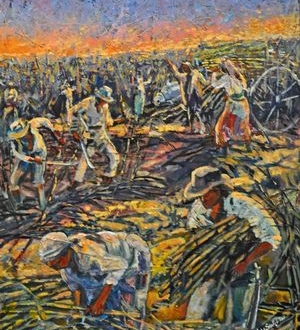Dr Kumar Mahabir takes a tour of the Indian Caribbean Museum in Trinidad, the only one of its kind dedicated to the preservation of the material history of over one million descendants of South Asians in the Caribbean Islands.
There are many types of museums in the world, and even within a single country. The major types include museums of art, science, sports and natural history. The Indian Caribbean Museum is a specialized museum like the Police Museum, the Money Museum, The Maritime Museum and the Angostura Museum of Trinidad and Tobago. Indeed, the establishment of such museums are important because they focus on specific themes to which the National Museum cannot do justice because of its limited size and city location.
 The museum’s large collection has been obtained through field trips by administrators of the institution. Most items have been acquired as gifts, bequests and loans by interested individuals, families, priests, historians, scholars and collectors of the island community. The collections include old and items such as rare musical instruments, agricultural objects, cooking utensils, pieces of clothing, ancient photographs and historical books. Some objects of historical and aesthetic value include a sapat [wooden slipper], jata [grinding stone], boli [gourd bowl], hassawa [grass knife], and aluminium scoop. On the museum’s grounds is a huge copper (“cuppa”) basin used for boiling cane syrup in the factory up to the 1930s, but afterwards adapted as water troughs for animals and water tanks for household use. There is also a wooden contraption used for pounding cocoa and coffee beans as well as corn and rice grains.
The museum’s large collection has been obtained through field trips by administrators of the institution. Most items have been acquired as gifts, bequests and loans by interested individuals, families, priests, historians, scholars and collectors of the island community. The collections include old and items such as rare musical instruments, agricultural objects, cooking utensils, pieces of clothing, ancient photographs and historical books. Some objects of historical and aesthetic value include a sapat [wooden slipper], jata [grinding stone], boli [gourd bowl], hassawa [grass knife], and aluminium scoop. On the museum’s grounds is a huge copper (“cuppa”) basin used for boiling cane syrup in the factory up to the 1930s, but afterwards adapted as water troughs for animals and water tanks for household use. There is also a wooden contraption used for pounding cocoa and coffee beans as well as corn and rice grains.
The Indian Caribbean Museum also houses an art gallery, a reference library and a computerized genealogical database. Soon to be established in the museum’s outdoor space is a botanical garden with some of the rare endangered plants of Indian origin like the (angled loofah), poi bhaji (Indian spinach), urdi (mung bean), and khakri (wild cucumber). There is a large permanent screen in a recessed wall of the museum for the showing of historical films and documentaries.
The museum is a non-profit organization, owned by the Sanathan Dharma Maha Sabha, with affiliation to government agencies like the Tourism Development Corporation (TDC) and The National Museum and Art Gallery of Trinidad and Tobago. It has a full-time and part-time professional staff whose primary responsibility is the acquisition, care and exhibition of objects for the benefit of the public.
The opening of the museum is the result of continuous collaboration, consultation, and cooperation with the people whose history has been preserved within its walls. The Indian Caribbean Museum is a national treasure, a keeper of culture, a window to the past, and an opportunity to see history come alive. To many visitors, it evokes memories of the past, a link to the present, and a vision for the future. The museum serves as a foundation for collective memory, cultural continuity and national development. It provides a common experience that families can share across generations, and serve as a link between revered ancestors and living people. This museum provides information on the cultural heritage of Indians in the Caribbean to Indians themselves, and to people of all other ethnic backgrounds.
The museum is dedicated to the collection, restoration, preservation, arrangement and exhibition of old material objects of Indians for the purposes of study, education and enjoyment. Although the Indian Caribbean Museum exhibits artifacts of a specific historical origin, and is owned by an individual organismic, it is committed to serving the general public. Like schools and libraries, museums provide public education to people of all ages. They are believed to be one of the most important institutions for educating children, and one of the most trustworthy sources of objective information. Eventually, the museum will embark on community out-reach programmes like public lectures, film screenings, and art and drama classes.
The Indian Caribbean Museum is open free of charge Wednesdays to Sundays from 10 a.m. to 5 p.m. It hopes to attract interested individuals, pilgrims, tourists, school children and sight-seeing groups. In addition to the cinema, zoo and botanical garden, the museum expects to be another destination during weekends and holidays for scores of families.
Author is an Assistant Professor at University of Trinidad and Tobago (UTT)






